Have you ever been confused with all the types of braces available out there: metal, ceramic, lingual, and the list is endless? Both have their strengths and weaknesses and understanding the differences will assist you in making a well-informed decision.
In this article, we will provide a brief introduction to a detailed description of each type of brace so that before you proceed to the next section, you are ready to select the most appropriate brace type that will suit your lifestyle and pocket. Prepare to find out which braces could be the best for you.
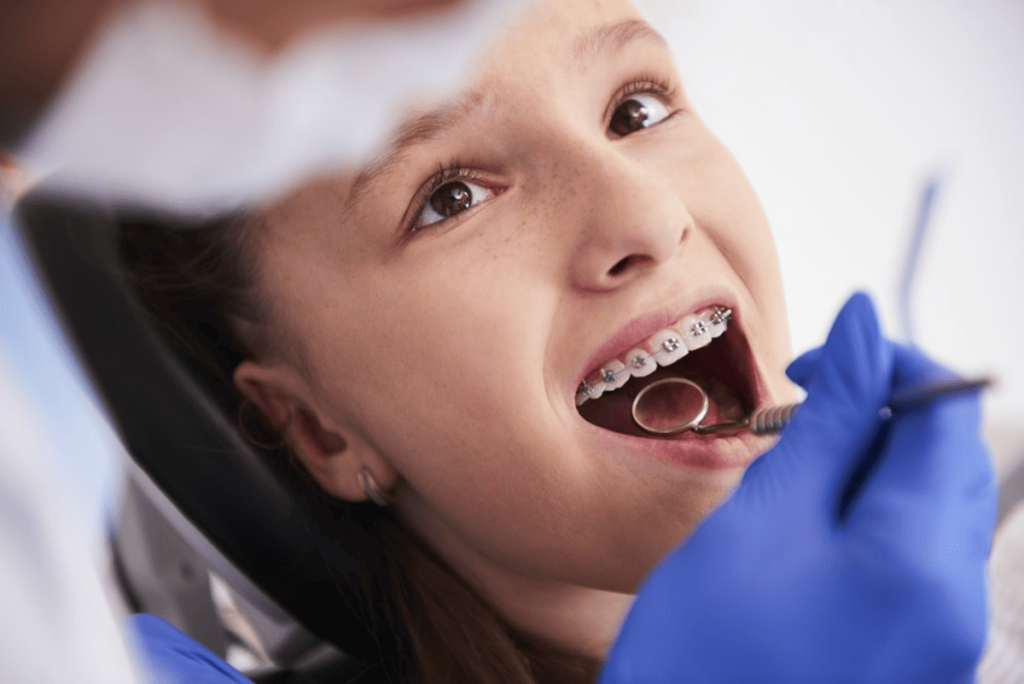
What are Dental Braces?
Dental braces are devices that are used to straighten out crooked teeth and fix any orthodontic issues that they have. They work by applying continuous pressure to the teeth over a while, gradually moving them into the desired position, and are typically made of brackets, wires, and elastics that can be adjusted periodically to ensure the teeth move as intended.
They are recommended for children and teenagers, but adults can wear them as well, depending on their requirements and usage, hence the different dental braces types. In this article, we will be exploring the different types of dental braces and cost.
The 5 Best Dental Braces Types
As explained in the paragraphs above, five different dental braces types are made available for the patient at the Dental Care clinic. We will be discussing each and every one of them as well as their cost and distinctive, unique features that set them apart from each other.
#1 Traditional Metal Braces
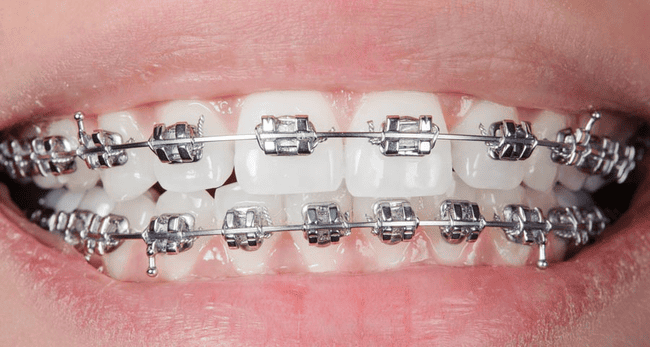
The most commonly used and effective orthodontic treatment method, this variant of the dental braces types can be traced as far back as 1819.
How it works
These braces work by attaching small metal brackets to the teeth and connecting them with wires to move the teeth into the desired position gradually. The brackets are placed on the teeth’s front surface, and the dentist then adjusts the wires to apply pressure and shift the teeth into the correct position over time.
Advantages
- Highly Effective: Capable of treating complex alignment and bite issues.
- Durable: Made of strong materials that resist breakage.
- Cost-Effective: Generally more affordable than other types of braces.
- Customizable: Patients can choose colorful elastic bands for a personalized touch.
Disadvantages
- Visibility: Metal braces are noticeable, which might not appeal to adults.
- Discomfort: This can cause irritation to the cheeks and gums, especially after adjustments.
Who Should Choose This Option?
Traditional metal braces are ideal for children, teenagers, and adults with complex orthodontic needs who are looking for an affordable and reliable solution.
#2 Ceramic Braces
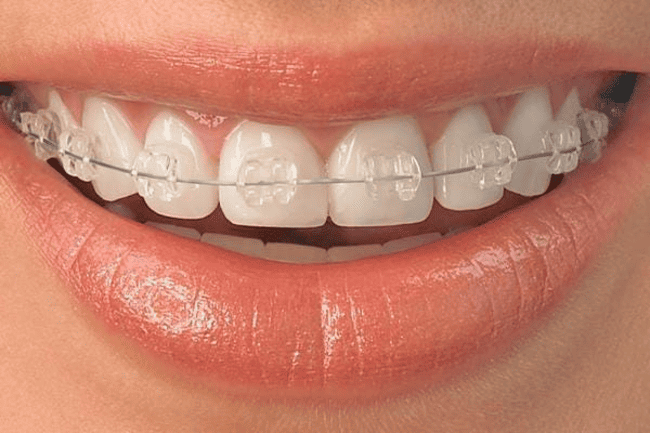
You may think that ceramic braces are among the different types of metal braces for teeth, but, believe it or not, they are actually quite similar to their traditional metal braces counterparts. They are sometimes known as ‘clear braces’ since
How it works
It involves the same methodology of using small brackets that are placed in front of the teeth where instead of metal, ceramic brackets are applied, and the brackets and wires of this dental braces types are made from clear or tooth-colored materials that blend in with the natural color of the teeth.
Advantages
- Aesthetic Appeal: Blend with the natural color of teeth for a less conspicuous look.
- Effective: Provides results comparable to metal braces for most orthodontic issues.
Disadvantages
- Cost: More expensive than traditional metal braces.
- Fragility: Ceramic brackets are more prone to breaking or chipping.
- Staining: Can discolor if not properly cared for.
Who Should Choose This Option?
Ceramic braces are a great choice for patients who want the effectiveness of traditional braces but with a more subtle appearance, especially adults and image-conscious teens.
#3 Lingual Braces
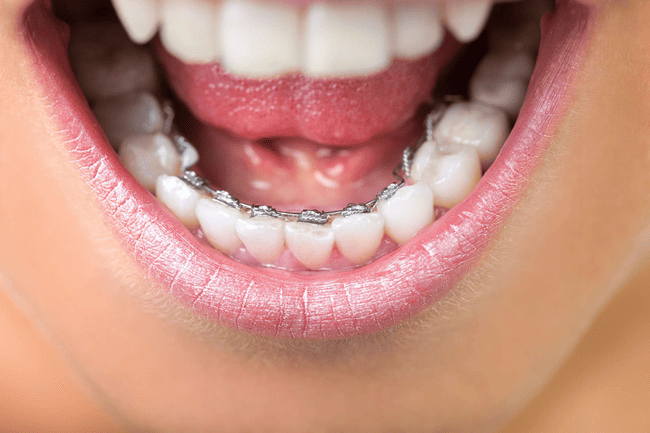
As evident in the nomenclature, this variant of the dental braces types involves having traditional metal braces being used but in the lingual direction of both upper and lower teeth.
How it works
By using specialized brackets and wires that are linked to the back of the teeth, lingual braces work by continuously exerting pressure on the teeth. (The same way the traditional metal braces work) and they are positioned using a specialized adhesive specially made to fit each patient’s unique dental pattern.
Advantages
- Completely Hidden: Ideal for individuals who want a discreet orthodontic solution.
- Effective: Can address complex Dental Care issues just like traditional braces.
Disadvantages
- Cost: Lingual braces are among the most expensive types of braces due to their customization.
- Discomfort: Can initially cause irritation to the tongue and affect speech.
- Maintenance: More challenging to clean due to their position.
Who Should Choose This Option?
Lingual braces are perfect for adults and professionals who prioritize aesthetics and don’t want their braces to be visible during treatment.
#4 Self-Ligating Braces
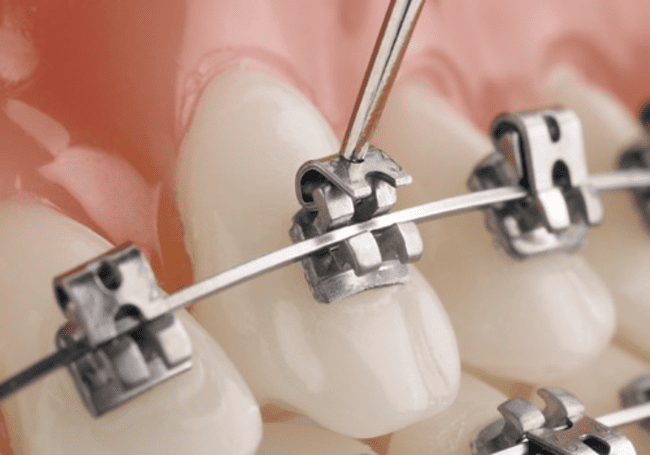
This variant of the dental braces types employs brackets, wires, and specialized mechanisms that place the wire without the need to use elastics or ties, resulting in shorter orthodontic treatment durations.
How it works
In this variant of the dental braces types, a specific clip or door mechanism is used in each bracket, and it lessens the force required to move the teeth from their original position, thus resulting in less friction and irritation in the oral cavity.
Advantages
- Faster Treatment: Reduced friction allows teeth to move more freely, potentially shortening treatment time.
- Easier Cleaning: Without elastic bands, they attract less plaque and are easier to maintain.
- Comfort: Patients often report less discomfort compared to traditional braces.
Disadvantages
- Cost: More expensive than traditional metal braces.
- Limited Color Customization: Lack of elastic bands means fewer personalization options.
Who Should Choose This Option?
Self-ligating braces are suitable for patients who want a more comfortable and efficient Dental Treatments experience, especially those who prioritize hygiene.
#5 Clear Aligners
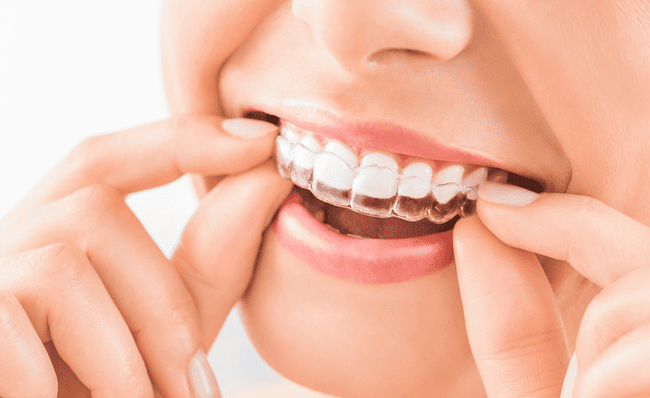
A uniquely different variant of the dental braces types, often called “invisible braces,” they work best as an alternative to braces where instead of brackets and wires, clear aligners use a series of custom-made trays to straighten your teeth over time.
How it works
Like in most orthodontic dental braces types, a constant yet gentle pressure is exerted on the teeth to move them from their original place to another one.
Advantages
- Invisibility: Virtually undetectable, making them a favorite among adults and teens.
- Removability: Can be taken out for eating, drinking, brushing, and flossing.
- Comfort: No brackets or wires to cause irritation.
Disadvantages
- Discipline Required: Must be worn for 20–22 hours per day to be effective.
- Cost: Often more expensive than traditional braces.
- Not for Complex Cases: Best suited for mild to moderate alignment issues.
Who Should Choose This Option?
Clear aligners are ideal for patients who want a discreet, flexible, and comfortable treatment option, provided their orthodontic needs aren’t overly complex.
How to Choose the Best Dental Braces Types for You?
Now that you know all 5 of the dental braces types, it is important to know which one would be the best option for your treatment (should you get one.) It all depends on your budget and your aesthetic concerns as well as compliance, but it is always recommended to opt for the traditional metal braces treatment if you have no aesthetic concerns.
Make sure you choose the option which is more comfortable for you and is more aesthetically pleasing for you as well, as long as you have the proper budget in your hand for any dental braces types.
FAQs
Q1: What is the ideal age for dental braces types to work?
Answer: Ideally, orthodontic treatment should be done between the ages of 13 to 18, regardless of gender, because this age duration is when the growth spurt happens.
Q2: How long does each different dental braces types take for treatment?
Answer: Self-Ligating and Clear Aligner variants of dental braces types take a shorter time, from 6 months to a year whereas the rest of the dental braces types take at least 2 to 3 years for it to work.
Q3: What should you eat when wearing dental braces types?
Answer: You should try eating soft foods when wearing any of the dental braces types and mostly liquid diet. If you do eat solid food, make sure you use special brushes to clean them.
Q4: How can you clean your mouth when using dental braces?
Answer: You can use special dental brushes or even water flossers to clean your braces efficiently.
Conclusion
And with the end of the article, we have discussed the five different dental braces types, their functions, advantages, disadvantages, AND the fact that which of them would be better for you. Be sure to visit Aidite’s website regularly to get more updates regarding dental content as well as the latest updates on our line of dental products because you will get the best dental tips and procedure advice from authentic dentists!



